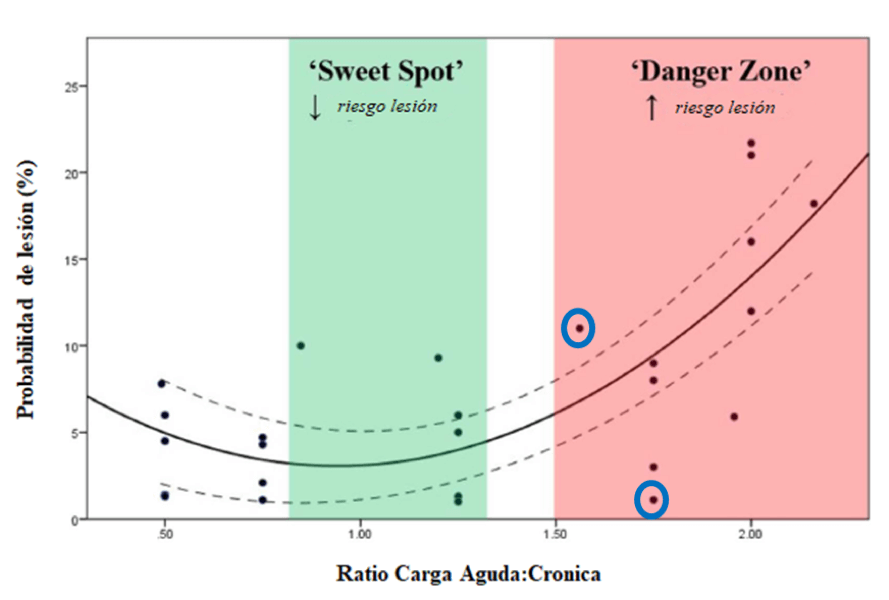July 2, 2018
Injury Management
Sports Performance
Team Sports
THE LEVEL OF RESISTANCE AS A MODERATOR OF THE TRAINING LOAD
Nowadays, physical trainers and/or coaching staff are trying to monitor and manage the training load in order to comply with a set of precepts which aim to optimize an athlete’s physical fitness without comprising his health. While trying to follow specific rules, coaches are paying special attention to monitoring the accumulated load during a determined temporal structure, the load change between weeks, and the acute:chronic load ratio, among others. The question we should ask ourselves is, are the limits to these rules the same for all players? Do they all respond in the same way to the 1.6 acute:chronic load ratio? Are all of our players equally sensitive to injury?
The inadequate management of training loads is thought to be one of the main contributing factors that predisposes athletes to injury. However, “errors” in training management increase the likelihood of injury in some groups of athletes more than others. Moderators have been defined as characteristics that allow athletes to withstand/tolerate the training load and minimize its damaging effects (Windt et al., 2017).

Cardiovascular endurance manifests as a moderator of the load result to which the athlete is exposed. In the case of soccer, recent investigations have found that the players with the lowest level of intermittent endurance were two to three times more likely to suffer an injury than the athletes with better performance on the 30-15 VIFT Test (Malone, Owen, Mendes, Hughes, Collins & Gabbett, 2017). Some of the results are shown below. The players with a lower intermittent endurance level (VIFT of 14.0-15.5 km·h-1) are more likely to suffer an injury when facing:
Weekly distance loads greater than 1,025 m (x3) covered at high speeds.
Weekly distance loads greater than 350 m (x5) covered in sprints.
Weekly changes in distance covered at high speed between 300-600 m (x3).
Acute:chronic load ratio >1.25 in distance covered at high speed (x4).
Acute:chronic load ratio >1.35 in distance covered at sprint (x4).
The values associated with x refer to the increased likelihood with respect to athletes with a higher endurance level (group with a VIFT between 20.0 and 22.5 km·h-1), such that, for example, the likelihood of injury is 5 times greater when the weekly distance covered at sprint exceeds 350 m in the group with a low intermittent endurance level compared to the group with a high intermittent endurance level.
Sign up for the Certificate in Workload Management in Football, designed by David Casamichana
In this sense, taking the fitness level of our athletes into account when managing training load is an interesting idea. Thus, when this capacity is evaluated, and athletes with low fitness levels are detected, their allowable load threshold should be reduced while we attempt to resolve this limitation. This is usually contrary to what is typically done in the soccer world, where the load that the players with the worse fitness levels tolerate or experience tends to be the highest of the entire team, since we add extra work to resolve this limitation to group training. Applying these load levels to players with low fitness levels could increase the likelihood of injury.
In contrast, athletes who are “injury-resistant” – with a high fitness level and without previous injuries – would allow greater training loads to be applied if we pursue certain performance objectives, since the modulators present will prevent this load from increasing the athlete’s likelihood of injury. Acute:chronic load ratios of 1.7 could turn out to be “safer” for these athletes, while the likelihood of injury would increase for athletes with a long history of previous injuries and/or low fitness level as we would find ourselves outside the safety zone.
David Casamichana Gómez, Doctor in Physical Activity and Sports Science. Physical trainer in soccer. University Professor and Researcher. Expert of the Certificate in Workload Management in Football at Barça Innovation Hub – Universitas.
References
Blanch, P., & Gabbett, T. J. (2016). Has the athlete trained enough to return to play safely? The acute: chronic workload ratio permits clinicians to quantify a player’s risk of subsequent injury. Br J Sports Med, 50(8): 471-475.
Malone, S., Owen, A., Mendes, B., Hughes, B., Collins, K., & Gabbett, T. J. (2017). High-speed running and sprinting as an injury risk factor in soccer: Can well-developed physical qualities reduce the risk? J Sci Med Sport, S1440-2440(17):30442-5.
Windt, J., Zumbo, B.D., Sporer, B., MacDonald, K., & Gabbett, T.J. (2017). Why do workload spikes cause injuries, and which athletes are at higher risk? Mediators and moderators in workload-injury investigations. Br J Sports Med, 51(13):993-994.
KNOW MORE
CATEGORY: MARKETING, COMMUNICATION AND MANAGEMENT
This model looks to the future with the requirements and demands of a new era of stadiums, directed toward improving and fulfilling the experiences of fans and spectators, remembering “feeling” and “passion” when designing their business model.
CATEGORY: FOOTBALL SPORTS PERFORMANCE
Through the use of computer vision we can identify some shortcomings in the body orientation of players in different game situations.
CATEGORY: MEDICINE HEALTH AND WELLNESS
A health check must detect situations which, despite not showing obvious symptoms, may endanger athletes subject to the highest demands.
CATEGORY: FOOTBALL TEAM SPORTS
In the words of Johan Cruyff, “Players, in reality, have the ball for 3 minutes, on average. So, the most important thing is: what do you do during those 87 minutes when you do not have the ball? That is what determines whether you’re a good player or not.”
CATEGORY: MEDICINE HEALTH AND WELLNESS SPORTS PERFORMANCE
Muscle injuries account for more than 30% of all injuries in sports like soccer. Their significance is therefore enormous in terms of training sessions and lost game time.
DO YOU WANT TO KNOW MORE?
- SUBSCRIBE
- CONTACT
- APPLY
KEEP UP TO DATE WITH OUR NEWS
Do you have any questions about Barça Universitas?
- Startup
- Research Center
- Corporate